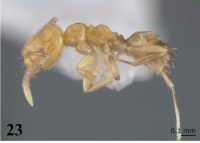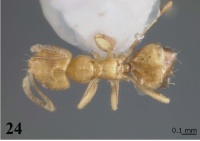Brachymyrmex delabiei
| Brachymyrmex delabiei | |
|---|---|

| |
| Scientific classification | |
| Kingdom: | Animalia |
| Phylum: | Arthropoda |
| Class: | Insecta |
| Order: | Hymenoptera |
| Family: | Formicidae |
| Subfamily: | Formicinae |
| Tribe: | Myrmelachistini |
| Genus: | Brachymyrmex |
| Species: | B. delabiei |
| Binomial name | |
| Brachymyrmex delabiei Ortiz & Fernández, 2014 | |
The type specimens from São Paulo at Tapiraí [USNM ENT 00757718 – 00757722] were collected in a pristine region of the Brazilian Atlantic Forest (R.M. Feitosa, pers. comm.). Habitat information is lacking for the other specimens.
Identification
This species differs from most other Brachymyrmex species by the presence of tumuliform metathoracic spiracles (see key for image of this character), and clypeus with five long, erect hairs arranged as follows: one central hair near to the anterior margin, usually conspicuous; one pair of lateral hairs at clypeus midlength and one pair of hairs near the toruli and from Brachymyrmex brasiliensis by its entirely smooth and shiny body. B. delabiei can be diagnosed from Brachymyrmex feitosai by the lack of dense pubescence on the first segment of the gaster and by the presence of erect hairs on the mesosoma; two on the pronotum and two on the mesonotum. (Ortiz & Fernández, 2014)
Keys including this Species
- Key to Brachymyrmex with tumuliform metathoracic spiracles
- Identification key to Brachymyrmex species
Distribution
Brazil: states of Bahia, Santa Catharina and São Paulo.
Latitudinal Distribution Pattern
Latitudinal Range: -15.60111111° to -27.74111111°.
| North Temperate |
North Subtropical |
Tropical | South Subtropical |
South Temperate |
- Source: AntMaps
Distribution based on Regional Taxon Lists
Neotropical Region: Brazil (type locality).
Distribution based on AntMaps
Distribution based on AntWeb specimens
Check data from AntWeb
Countries Occupied
| Number of countries occupied by this species based on AntWiki Regional Taxon Lists. In general, fewer countries occupied indicates a narrower range, while more countries indicates a more widespread species. |

|
Estimated Abundance
| Relative abundance based on number of AntMaps records per species (this species within the purple bar). Fewer records (to the left) indicates a less abundant/encountered species while more records (to the right) indicates more abundant/encountered species. |

|
Biology
Castes
Known only from the worker caste.
Nomenclature
The following information is derived from Barry Bolton's Online Catalogue of the Ants of the World.
- delabiei. Brachymyrmex delabiei Ortiz, C.M. & Fernández, 2014: 24, figs. 22-24, 28 (w.) BRAZIL (São Paulo, Bahia, Santa Catarina).
- Type-material: holotype worker, 3 paratype workers.
- Type-locality: holotype Brazil: São Paulo, Tapiraí, 24°01’55.5’’S, 47°27’56’’W, 8-14.i.2001, Transecto 1, Winkler 23 (R.R. Silva & Eberhardt); paratypes with same data.
- Type-depositories: MZSP (holotype); CPDC, ICNB, USNM (paratypes).
- Status as species: Ortiz-Sepúlveda, et al. 2019: 491.
- Distribution: Brazil.
Unless otherwise noted the text for the remainder of this section is reported from the publication that includes the original description.
Description
Worker
Holotype measurements (mm). HL1 0.38; HL2 0.29; HL3 0.08; HW 0.32; SL 0.32; EL 0.07; WL 0.40; PnL 0.12; PnW 0.22; ML 0.07; MW 0.13; Indices CI 83.7; SI1 102.8; SI2134.4; OI 22.2. Paratypes measurements (mm) (n=3). HL1 0.34 – 0.41; HL2 0.22 – 0.30; HL3 0.06 – 0.09; SL 0.31 – 0.36; EL 0.07 – 0.09; WL 0.35 – 0.43; PnL 0.09 – 0.13; PnW 0.15 – 0.24; ML 0.07 – 0.12; MW 0.13 – 0.17; Indices CI 83.7 – 93; SI 97 – 119; SI2112 – 135; OI 21.05 – 26. Additional material examined measurements (mm) (n=4). HL1 0.34 – 0.41; HL2 0.22 – 0.28; HL3 0.06 – 0.09; SL 0.31 – 0.36; EL 0.08 – 0.09; WL 0.30 – 0.43; PnL 0.10 – 0.12; PnW 0.15 – 0.20; ML 0.07 – 0.12; MW 0.15; Indices CI 88.8 – 92; SI1 97 – 100; SI271 – 78; OI 25.
Head slightly longer than wide, sides slightly convex. Posterior cephalic border flat, slightly concave in the middle. Anterior clypeal margin rounded. Toruli surpassing the posterior clypeal margin (best observed in anterodorsal oblique view). Scapes surpassing the posterior margin of the head. Ocelli present. Eyes situated below the cephalic midline and well developed with 7–9 ommatidia at their maximum diameter.
Promesonotum convex in profile. Mesonotum strongly convex, rounded and separated from pronotum. Propodeum strongly convex with short dorsum. Metathoracic spiracles fully dorsal, tumuliform, bulging out of the metanotal groove in lateral view, equidistant in diameter from metanotal groove and from the propodeal folding. Propodeal spiracle round, elevated from integument on the propodeal border. Petiole short and inclined forward.
Body smooth and shiny. Dorsum of head, promesonotum, and propodeum with short appressed hairs. Scapes with suberect and subdecumbent hairs. Clypeus with five long, erect hairs arranged as follows: one central hair near to the anterior margin, usually conspicuous; one pair of lateral hairs at clypeus midlength and one pair of hairs near the toruli. Gaster with several scattered long erect hairs, without dense pubescence. Mesosoma with erect hairs, two on the pronotum and two on the mesonotum. Body yellowish.
Type Material
Holotype worker (Museu de Zoologia da Universidade de Sao Paulo) [USNM ENT 00757718] and Paratypes 3 workers (Laboratório de Mirmecologia CEPEC / CPDC [USNM ENT 00757719], (ICN) [USNM ENT 00757720], National Museum of Natural History [USNM ENT 00757721]): Brazil, São Paulo, Tapiraí, 24°01'55.5"S 47°27'56"W, 08–14 Jan 2001, col. R.R. Silva & Eberhardt, Transecto 1 Winkler 23.
Etymology
We are pleased to name this ant in honor of Dr Jacques Delabie (CPDC) for his contribution to ant taxonomy and biology and his unconditional support for many ant biologists working in the Neotropics.
References
- Ortiz, C.M. & Fernández, F. 2014. Brachymyrmex species with tumuliform metathoracic spiracles description of three new species and discussion of dimorphism in the genus (Hymenoptera, Formicidae). ZooKeys 371, 13-33.
- Ortiz-Sepulveda, C.M., Van Bocxlaer, B., Meneses, A.D., Fernández, F. 2019. Molecular and morphological recognition of species boundaries in the neglected ant genus Brachymyrmex (Hymenoptera: Formicidae): toward a taxonomic revision. Organisms Diversity & Evolution (DOI 10.1007/s13127-019-00406-2).
References based on Global Ant Biodiversity Informatics
- Ortiz C. M., and F. Fernández. 2014. Brachymyrmex species with tumuliform metathoracic spiracles: description of three new species and discussion of dimorphism in the genus (Hymenoptera, Formicidae). ZooKeys 371: 13-33.
- Ortiz-Sepuvelda C. M., B. Van Bocxlaer, A. D. Meneses, and F. Fernandez. 2019. Molecular and morphological recognition of species boundaries in the neglected ant genus Brachymyrmex (Hymenoptera: Formicidae): toward a taxonomic revision. Organisms Diversity & Evolution https://doi.org/10.1007/s13127-019-00406-2

